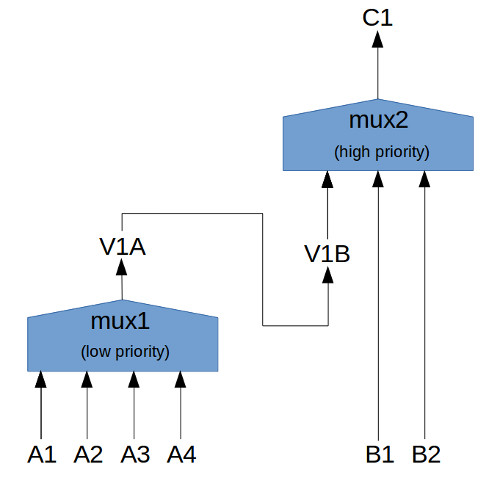Virtual Ports
The Cisco Nexus 3550-F Fusion (formerly ExaLINK Fusion) has the concept of virtual ports. A virtual port pair can be thought of as a pipe with an A side and a B side, where traffic flows in both directions between A and B. Each side of a virtual port can be connected to another Nexus 3550-F object, enabling a range of network and data flow possibilities.
Virtual ports are created using the virtual-port command, and must be named
in the format Vnumber, for example:
admin@N3550-F> config virtual-port V1
Created virtual port pair V1A and V1B
As with other commands, virtual ports can be removed with the no virtual port
command.
Once created, each side of the virtual port can be used like any other port. The following contrived example shows a simple use of virtual ports:
admin@N3550-F> config
admin@N3550-F(config)> patch A1 V1A
Patch created between port "A1" and port "V1A"
admin@N3550-F(config)> patch A2 V1B
Patch created between port "A2" and port "V1B"
This would effectively create a patch between A1 and A2. Note this
could have been done with patch A1 A2, however the intention here is to
describe the use of virtual ports.
A more realistic example use of these objects would be if a user wanted to aggregate traffic from a number of servers towards a single destination, where some servers are considered higher priority than others. This could be implemented by the use of cascaded mux objects as follows:

Cascaded mux objects joined by an external patch cable
The use of virtual ports allows this cascading to be done without the external patch cable, for example:

Cascaded mux objects joined by virtual ports
The config to implement this would be:
admin@N3550-F> config
admin@N3550-F(config)> virtual-port V1
Created virtual port pair V1A and V1B
admin@N3550-F(config)> mux mux1
Created mux "mux1"
admin@N3550-F(config-mux:mux1)> port A1; port A2; port A3; port A4
Added downstream port "A1" to mux "mux1"
Added downstream port "A2" to mux "mux1"
Added downstream port "A3" to mux "mux1"
Added downstream port "A4" to mux "mux1"
admin@N3550-F(config-mux:mux1)> port upstream V1A
Added upstream port "V1A" to mux "mux1"
admin@N3550-F(config-mux:mux1)> exit
admin@N3550-F(config)> mux mux2
Created mux "mux2"
admin@N3550-F(config-mux:mux2)> port V1B, port B1; port B2
Added downstream port "V1B" to mux "mux2"
Added downstream port "B1" to mux "mux2"
Added downstream port "B2" to mux "mux2"
admin@N3550-F(config-mux:mux2)> port upstream C1
Added upstream port "C1" to mux "mux2"
This page was last updated on Feb-19-2021.